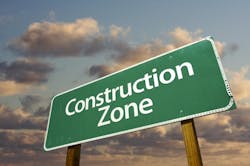Roller chains — first sketched out by Leonardo da Vinci in the 16th Century — are a primary power-transmission drive in myriad industries, including the taxing construction and mining industries. That's because they effectively transmit power and convey products.
1. Adhere to a maintenance schedule.
Roller chains in your conveyors (and their sprockets) need regular inspection and service. Have maintenance check them on a regular basis for proper tension, lubrication, and alignment. In a correctly sized and installed drive, roller chains can be expected to last for approximately 15,000 hours. Smaller tasks such as chain adjustments and oil and filter changes should be scheduled for every three months, while bigger tasks — such as cleaning the components, aligning the shafts, relubricating the whole machine, replacing or servicing worn and damaged sideplates and sprockets, and unclogging the feed pipes — should be completed annually.
It's particularly important to adhere to maintenance schedules when roller chains work in mining and construction. Without regular service, heavy-duty machinery can fail and cause injuries, not to mention project delays.
Tip: A comprehensive maintenance schedule helps project managers and clearly outlines what needs to be done and when. Most items that need to be addressed are all easily able to be adjusted and maintained when done on a regular basis, and will keep machinery lasting the distance and workers safe.
2. Choose the oil and method of lubrication wisely.
Roller chains and drives need to be protected against dirt and moisture to run smoothly.
• Manual lubrication
• Drip lubrication
• Disk lubrication
• Stream lubrication
Which is best? That depends on the chain speed and power transmitted by the piece of equipment. Note: Proper lubrication of roller chains is paramount. It reduces wear and offers other benefits like heat dissipation. Good lubricant also cushions impact loads.
3. Look for chains with properly heat-treated subcomponents.
Mechanical components can be improved and degraded by heat treatment. So, for effective working results, the manufacturer must precisely control such treatment of any parts for it to do any good. In other words, proper heat treatment is crucial to extending wear life, but more harm than good can result if it’s not done properly.
The two key elements of heat transfer of the components are case depth and case hardness. These must be in ranges that maximizes durability and resistance. When the depth of the case hardness is too deep, the part can become brittle and break away during operation.
4. Ensure the right tension and alignment.
The chain tension in the slack span should be consistently checked and maintained to see if it needs adjusting. If the tension exceeds the available adjustment, remove two pitches and reconnect the chain. The entire chain will have to be replaced however, if the wear exceeds functional limits or is greater than 3% (.36 inches in a foot). New chains should not be connected to a worn chain because it can become rough and damage the drive. If the chain is worn beyond this 3%, operation should not continue. That's because if it's run anyway, damage will spread through to the roller chain sprockets.
Any noticeable wear on the inside surface of the roller chain’s link plates arises from misaligned sprockets. But regular checks of the sprockets prevent additional abnormal sprocket and chain wear.
5. Get hardened parts to prevent wear and failure.
For majority of the machinery in the construction and mining industry, the main drawbacks with roller chain is this wear in both the chain and the sprockets. This is the primary cause for the chain stretching, eventually leading to failure and a full replacement of the chain and sprockets will need to be done.
To combat this problem, get solid roller chains that manufactured with parts boasting high surface hardness. This significantly improves the wear resistance, extends life, and boosts performance in harsh environments.
Roller chains should be thoroughly inspected for deformed, cracked or broken parts. If any of these conditions are found, replace the entire chain ... regardless of whether parts of the chain looks to be good condition.
About the author: Jayde Ferguson writes for Statewide Bearings, an Australian-based manufacturer and supplier of bearings and roller chains.


